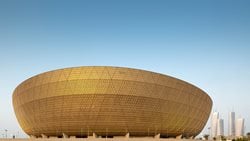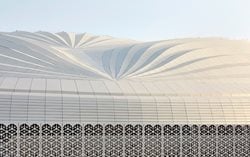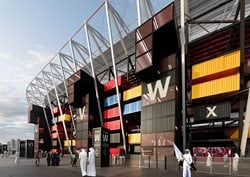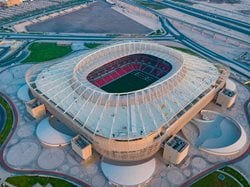
The FIFA World Cup Qatar 2022™, the first to be hosted in an Arab country, got underway yesterday at Al Bayt Stadium after a stunning opening ceremony.
The 30-minute opening ceremony, narrated by Academy Award-winning actor Morgan Freeman and featuring Jung Kook from Korean supergroup BTS, showcased Qatari culture and heritage while highlighting football’s ability to unite people from different countries and cultures.
 ©Supreme Committee for Delivery & Legacy
©Supreme Committee for Delivery & Legacy

©Supreme Committee for Delivery & Legacy
The matches will be played in eight highly ecological, recyclable, and future-oriented venues; seven stadiums were built in the last 3 years and one recently extensively refurbished.
Lusail Stadium, the largest of the World Cup stadiums, was designed by Foster + Partners.
With its 80,000 seats, the centrepiece venue for the FIFA World Cup Qatar 2022™ will host most matches, including the long-awaited final.
The seating bowl is expressed externally as a burnished golden vessel, which sparkles against the sunlight.
After the World Cup, it should be converted into a multipurpose center.

©Nigel Young / Foster + Partners
Al Janoub Stadium, designed by Zaha Hadid Architects, opened in May 2019.
The stadium will host the group and quarter-final matches of the tournament. It is located in the city of Al Wakrah, 20km south of Doha and connected to the capital via the Red Line of the new Doha Metro system.
The stadium’s roof design is an abstraction of the hulls of dhows turned upside-down and huddled together to provide shade and shelter. This is expressed in the stadium’s envelope geometry, details and selected materiality, including the roof’s beam structure that echoes the interior structure of a dhow’s hull.
The facades of the stadium are slanted outwards, tapered in elevation and reminiscent of the pleating of a dhow’s sails.
Since some of its facilities have been conceived as temporary, the effective seats after the World Cup will be reduced from 40,000 to around 20,000. The temporary seats have been designed to be demountable and transportable to a developing country in need of sporting infrastructure for post-tournament usage.
 ©Supreme Committee for Delivery & Legacy
©Supreme Committee for Delivery & Legacy
Stadium 974 | Ras Abu Aboud Stadium
Stadium 974 | Ras Abu Aboud Stadium is the only waterfront facility with a spectacular view of the Doha skyline. The stadium, designed by RFA - Fenwick Iribarren Architects using 974 shipping containers and modular steel elements, echoes the nearby port and industrial history of the lot it stands on. The result is a 40,000 seats, boldly colored and modern arena, whose modular design has made it possible to use a reduced number of building materials, thus contributing to the containment of construction costs.
©Supreme Committee for Delivery & Legacy
Ahmad Bin Ali Stadium
The Ahmad Bin Ali Stadium by BDP Pattern is located in Al Rayyan, known in Qatar as the ‘gateway to the desert’ and for its strong connection to the country’s traditional culture and heritage.
The conceptual theme for the site is the Desert. This translates into a masterplan concept of a caravan or journey in the desert landscape configured using a circle packing geometry.
A key feature of the stadium is its elegant, ornate façade: a contemporary interpretation of traditional Naquish patterns specific to Qatari culture.

©Supreme Committee for Delivery & Legacy
The Education City Stadium has the joint signature of BDP Pattern and RFA - Fenwick Iribarren Architects who conceived the façade as a shimmering diamond nestled on a vibrant landscaped podium.
The faceted nature of the metallic fabric façade has a strong geometric tessellation consisting of diamonds and triangles, which means each panel will reflect different qualities of light, sparkle with different hues, and mirror different aspects of the surrounding site. The movement of the sun throughout the day will animate and transform the appearance of the Stadium, creating an illusion of constant motion, whilst at night its inner glow will emanate out through the façade.
The project has been awarded Five-Stars under the Global Sustainability Assessment System (GSAS), making it the first stadium in the world to achieve such recognition. At least 55% of the materials used on the project come from sustainable sources and 28% of construction materials have recycled contents.

©Supreme Committee for Delivery & Legacy
Al Thumama Stadium
The stadium’s design represents the gahfiya – a traditional woven cap worn by men and boys across the Middle East.
The stadium’s capacity will be reduced to meet local needs and provide quality sporting infrastructure to developing nations. The remaining 20,000-seat arena will be used for football and other sporting events. A branch of a sports clinic will open on site, as well as a boutique hotel, which will replace the stadium’s upper stands.
 ©Supreme Committee for Delivery & Legacy
©Supreme Committee for Delivery & Legacy
Al Bayt Stadium
Al Bayt Stadium hosted the opening match of the FIFA World Cup Qatar 2022™ and will the venue for other matches including the semi-finals stage.
This 60,000-capacity stadium takes its name from ‘bayt al sha’ar’ – which were tents historically used by nomadic peoples in Qatar and the Gulf region. The design honours Qatar’s past and present, while keeping one eye on the future of the community.
The modular upper tier will be removed after the tournament, with the seats being re-purposed to create sporting facilities in Qatar and overseas.
After Qatar 2022, the upper concourse of the stadium will be converted into various facilities.
The sky box level will be turned into a five-star hotel, while a shopping centre, food court, gym and multipurpose hall will be incorporated into the stadium building. A leading sports medicine hospital will open. ©Supreme Committee for Delivery & Legacy
©Supreme Committee for Delivery & Legacy
Khalifa Stadium
The Khalifa International Stadium, located about 11 km from Doha, is the oldest stadium.
Built in 1976, Khalifa International Stadium has hosted the Asian Games, Arabian Gulf Cup and AFC Asian Cup. In 2019, it hosted the IAAF World Athletics Championships.
The stadium underwent an extensive redevelopment in order to prepare it for the FIFA World Cup Qatar 2022™.
The stadium's dual arches remained intact following the redevelopment and have now been complemented by a wide canopy below which supports the stadium's integration of the new cooling system.
The new tier added 10,450 seats to the capacity, while the stadium now features a new facade.
 ©Supreme Committee for Delivery & Legacy
©Supreme Committee for Delivery & Legacy


 29
29
 30
30
 0
0
 0
0
 17
17
comment